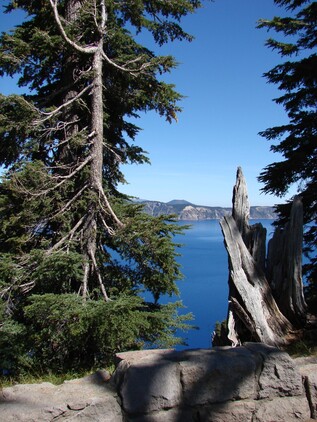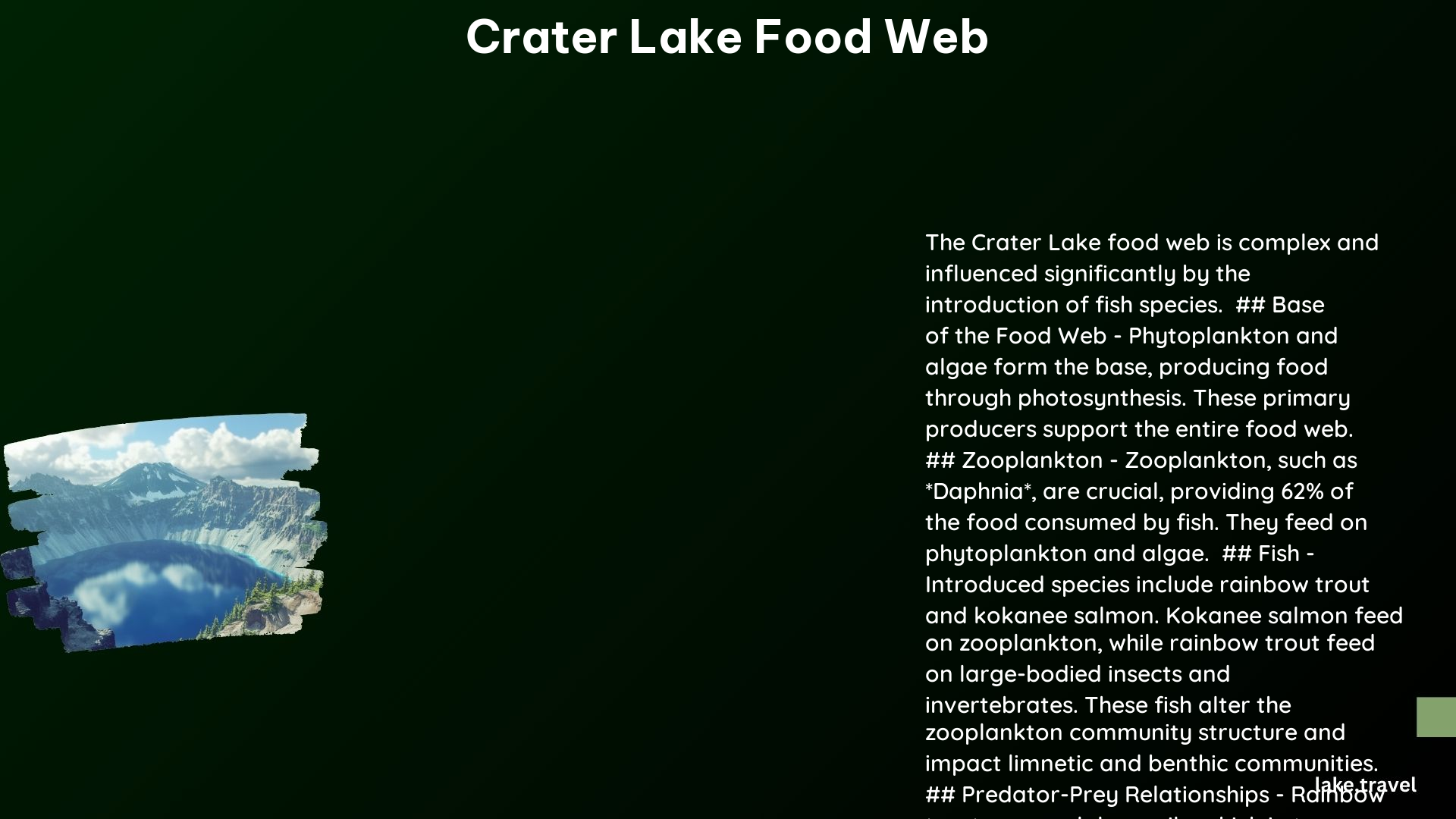Crater Lake’s food web is a delicate and intricate system, characterized by its ultra-oligotrophic nature and unique species interactions. This ecosystem, formed in a volcanic caldera, supports a diverse array of organisms from microscopic phytoplankton to introduced fish species. The food web’s structure, trophic levels, and species dynamics play crucial roles in maintaining the lake’s renowned clarity and ecological balance.
What are the Primary Producers in Crater Lake’s Food Web?

The foundation of Crater Lake’s food web lies in its primary producers, which are predominantly phytoplankton and benthic algae. These organisms form the base of the aquatic food chain, supporting all higher trophic levels.
Phytoplankton: The Microscopic Powerhouses
- 160 taxa of phytoplankton identified in Crater Lake
- Thrive despite low nutrient levels (ultra-oligotrophic conditions)
- Peak chlorophyll concentration less than 2 µg/l
- Concentrated in deeper lake layers
Benthic Algae: The Shoreline Greeners
- Grow on lake substrate and rocks
- Increased presence due to non-native crayfish introduction
- Contribute to “greening” of the shoreline
- Benefiting from reduced grazing pressure or increased nutrient availability
How is the Trophic Structure Organized in Crater Lake?

The trophic structure of Crater Lake’s food web consists of several interconnected levels, each playing a vital role in the ecosystem’s functionality.
- Primary Producers
- Phytoplankton
-
Benthic algae
-
Primary Consumers
- Zooplankton (e.g., Daphnia)
-
Benthic insects
-
Secondary Consumers
- Kokanee Salmon
-
Rainbow Trout
-
Tertiary Consumers
- Humans (through fishing)
- Terrestrial predators (indirectly)
What are the Key Species Interactions in Crater Lake’s Food Web?
The dynamics of species interactions in Crater Lake’s food web are complex and multifaceted, involving various predator-prey relationships and ecological impacts.
Predator-Prey Relationships
- Fish-Zooplankton Interaction
- Kokanee Salmon primarily feed on zooplankton
- Daphnia provide 62% of fish food mass
-
Fish regulate zooplankton population
-
Rainbow Trout-Lake Snails Cycle
- Rainbow Trout consume lake snails (10% of diet)
-
Snails act as decomposers for deceased trout
-
Crayfish-Benthic Insects Impact
- Non-native crayfish prey on benthic insects
- Reduced grazing pressure on benthic algae
Ecosystem Impacts
| Interaction | Impact |
|---|---|
| Fish-Zooplankton Balance | Maintains phytoplankton levels and water clarity |
| Crayfish Introduction | Disrupts native ecosystem, threatens Mazama newts |
| Human Fishing | Manages non-native fish populations |
What Specific Measurements Define Crater Lake’s Food Web?
Understanding the quantitative aspects of Crater Lake’s food web provides insights into its functioning and health.
- Phytoplankton Biomass: Peak chlorophyll concentration < 2 µg/l
- Zooplankton Contribution: Daphnia provide 62% of fish food mass
- Crayfish Spread: Nearly 95% of lake shoreline affected
- Fish Population Management: Controlled through fishing regulations
How Do Non-Native Species Affect Crater Lake’s Food Web?
The introduction of non-native species has significantly impacted Crater Lake’s ecosystem, altering existing relationships and creating new dynamics.
Crayfish Impact
- Spread to 95% of lake shoreline
- Predation on benthic insects
- Increased benthic algae growth
- Threat to Mazama newt populations
Introduced Fish Species
- Kokanee Salmon and Rainbow Trout not native to the lake
- Managed through fishing to prevent overpopulation
- Altered zooplankton dynamics and nutrient cycling
What Conservation Efforts are in Place for Crater Lake’s Food Web?
Preserving the delicate balance of Crater Lake’s food web requires ongoing conservation efforts and management strategies.
- Monitoring Programs
- Long-term limnological monitoring
-
Regular assessment of water quality and species populations
-
Fishing Regulations
- Controlled fishing to manage non-native fish populations
-
Preservation of ecosystem balance
-
Invasive Species Management
- Efforts to control crayfish population
-
Protection of native species habitats
-
Research Initiatives
- Ongoing studies on ecosystem dynamics
- Assessment of climate change impacts on the food web
How Does Crater Lake’s Food Web Compare to Other Lake Ecosystems?
Crater Lake’s food web stands out due to its unique characteristics and ultra-oligotrophic nature.
Unique Features
- Exceptionally clear water
- Low nutrient levels
- Limited number of fish species
- Absence of native top predators within the lake
Comparative Analysis
| Aspect | Crater Lake | Typical Lake Ecosystems |
|---|---|---|
| Nutrient Levels | Ultra-oligotrophic | Varies (oligotrophic to eutrophic) |
| Primary Producers | Mainly phytoplankton | Phytoplankton and aquatic plants |
| Fish Diversity | Limited, introduced species | Often higher, with native species |
| Top Predators | Absent within lake | Usually present (e.g., large fish) |
Crater Lake’s food web represents a unique and delicate ecosystem, shaped by its volcanic origin and subsequent ecological developments. The interplay between primary producers, consumers, and the impact of introduced species creates a complex web of interactions. Understanding and preserving this ecosystem is crucial for maintaining the lake’s renowned clarity and ecological integrity. Ongoing research and conservation efforts continue to provide valuable insights into this remarkable aquatic environment.
References:
1. https://craterlake-wes-apbio.weebly.com/ecosystem-relationships.html
2. https://craterlakee.weebly.com/food-web.html
3. https://www.nps.gov/crla/learn/nature/upload/LTLMP_report_2020-508.pdf
